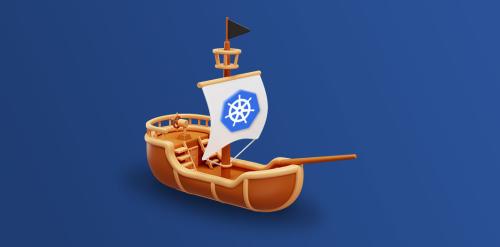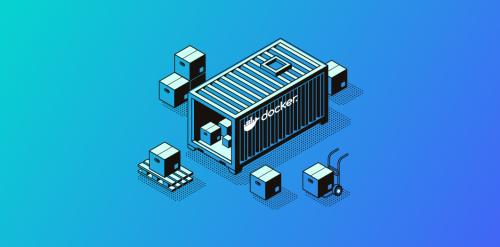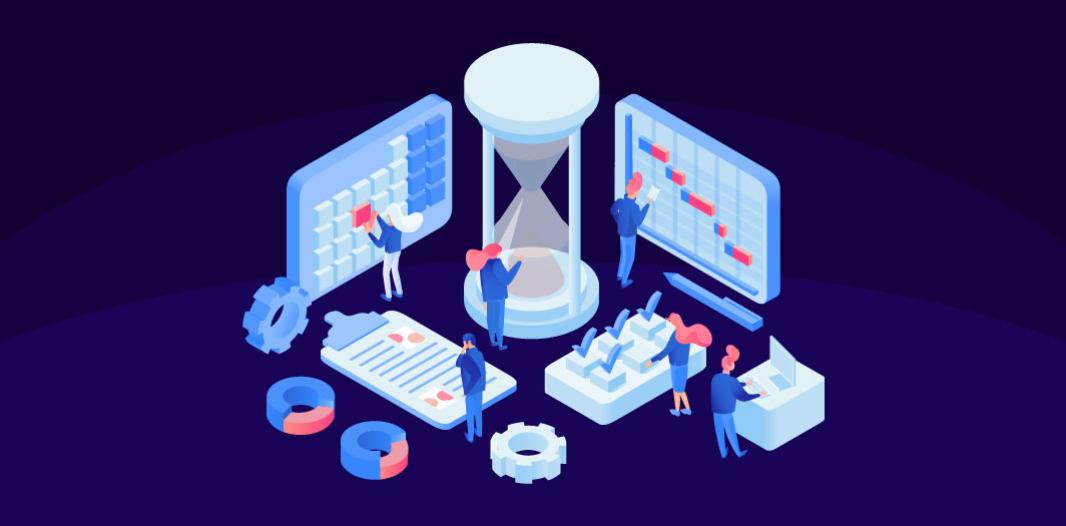
Agile Methodologies 101: How to Succeed in Drupal Development Project with Scrum
No matter how good your project idea is, it can fail if executed poorly. Proper project management is crucial for creating a product on time and efficiently while meeting all stakeholders' and users' needs.
That's why at Connect-i, we attach great importance to the development process organization. Today, we will talk about the most popular project management approach — Agile, and the Agile methodology that proved to bring the best results for our team and customers — Scrum.
What is Agile?
Agile is a flexible and collaborative software development approach based on iterative and incremental product delivery, as opposed to a traditional, linear development model.
In traditional waterfall software development, the word of the contract was more important than bringing actual value to the customer. Developers had to strictly follow a fixed sequence of steps to build a fully-fledged product on the first try. A customer could only see the product at the end of development and could not add any changes without renegotiating a new contract. Development cycles were lengthy, and fixing issues was costly.
Frustrated about this state of affairs, 17 luminaries in the software development community gathered in 2001 in Snowbird, Utah, and created the Manifesto for Agile Software Development.
The Manifesto for Agile Software Development
The meeting members had been working on new development frameworks for a while and saw that their vision of the main issues and solutions aligned. Thus, the Manifesto for Agile Software Development was born, proclaiming four core values of software development:
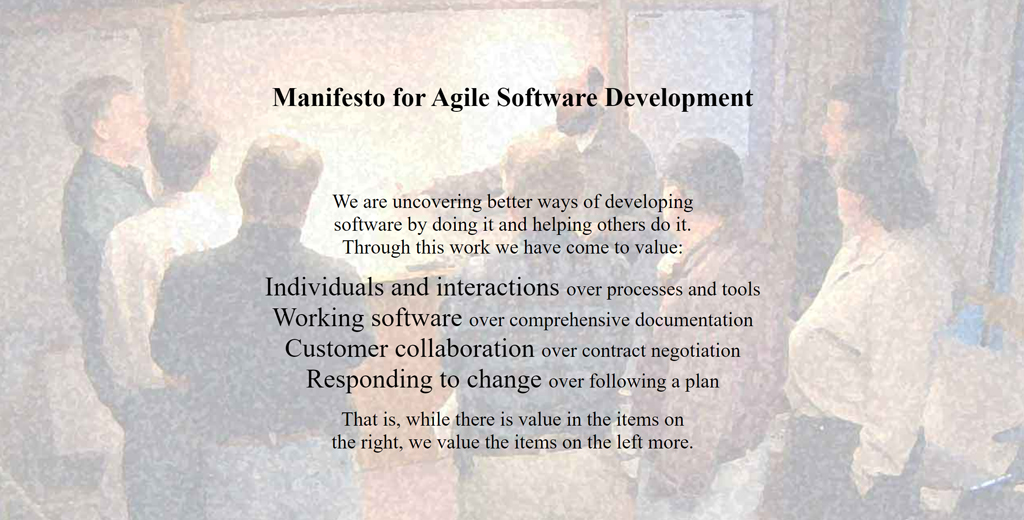
The Snowbird 17 group provided more specific guidance on applying these values with Twelve Principles of Agile Software, including delivering working software frequently, welcoming changing requirements, collaborating with business people daily, trusting teams to self-organize and do their jobs, and maintaining a sustainable pace of work:
Principles behind the Agile Manifesto
- Our highest priority is to satisfy the customer through early and continuous delivery of valuable software.
- Welcome changing requirements, even late in development. Agile processes harness change for the customer's competitive advantage.
- Deliver working software frequently, from a couple of weeks to a couple of months, with a preference to the shorter timescale.
- Business people and developers must work together daily throughout the project.
- Build projects around motivated individuals. Give them the environment and support they need, and trust them to get the job done.
- The most efficient and effective method of conveying information to and within a development team is face-to-face conversation.
- Working software is the primary measure of progress.
- Agile processes promote sustainable development. The sponsors, developers, and users should be able to maintain a constant pace indefinitely.
- Continuous attention to technical excellence and good design enhances agility.
- Simplicity — the art of maximizing the amount of work not done — is essential.
- The best architectures, requirements, and designs emerge from self-organizing teams.
- At regular intervals, the team reflects on how to become more effective, then tunes and adjusts its behavior accordingly.
The Agile Manifesto and its principles gained traction within the software development community, and organizations began adopting methodologies based on the agile approach, seeking more flexibility and responsiveness in their development processes.
The Agile Methodologies
Many agile frameworks emerged throughout the years, each for implementing Agile principles in different use cases, e.g., Adaptive Software Development, Extreme Programming, Crystal Clear, Scaled Agile Framework, etc. The two most popular ones are Scrum and Kanban.
Scrum revolves around iterative development cycles, regular reviews and adaptation, defined team roles, and incremental software delivery.
Kanban focuses on optimizing workflow and continuous delivery by limiting work in progress to meet the team capacity and visualizing work progress on a Kanban board for better transparency and a high-level overview.
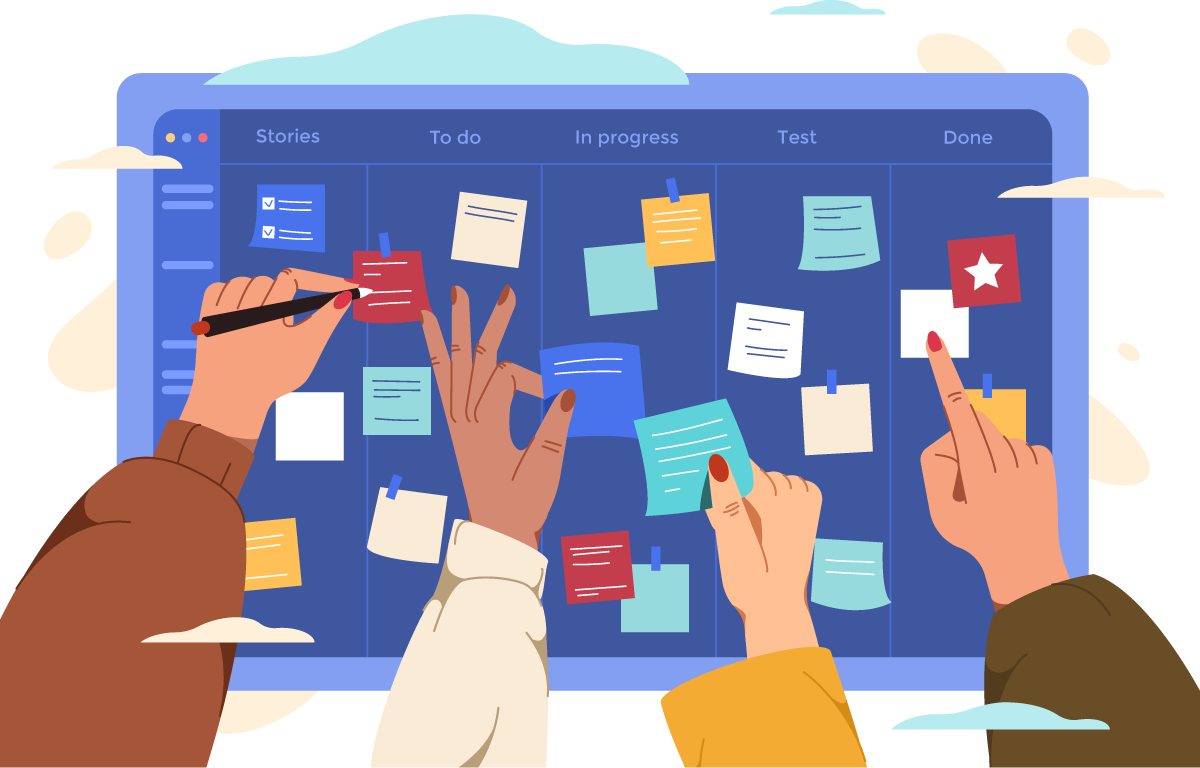
There isn't a "golden standard" or one-size-fits-all methodology in Agile. The most effective Agile approach is the one that aligns with the specific goals and challenges of a given project and organization. Moreover, teams may combine elements of different frameworks or customize practices to suit their unique needs.
For the Connect-i team, the best-fitting methodology turned out to be Scrum.
What is the Scrum Framework?
Scrum is an agile project management framework that helps small cross-functional teams tackle complex projects incrementally, in short, fixed-length release cycles, by continuously learning from feedback.
The term "scrum" came from rugby, referring to a dynamic and fast-paced game phase where players pack closely together and try to gain possession of the ball.

The Scrum framework consists of several key components, including specific team roles, events (or ceremonies), and artifacts. These elements work together to provide a structured yet flexible approach to Agile software development. Here's an overview of the core components of the Scrum framework:
Team Roles:
Product Owner represents stakeholders' interests and collaborates with the team to clarify requirements, define the product backlog, and prioritize features.
Scrum Master ensures adherence to Scrum principles, helps the team remove impediments, and fosters a culture of continuous improvement.
Development team is responsible for delivering a shippable product. The team is cross-functional, with specialists in UX/UI design, back end, front end, QA, etc., but comparatively small, usually under ten people.
Events:
Sprint is a basic unit of development iteration in Scrum, at the end of which the team delivers a potentially shippable product increment. Sprint is time-boxed, typically 2-4 weeks long. The sprint length stays constant throughout the whole development process as a benchmark for all other activities and improvements.
Sprint planning is a meeting at the beginning of each sprint, where the Product Owner and team collaborate to define the sprint goal and select user stories for the sprint backlog.
Stand-up is a short daily meeting facilitated by the Scrum Master, where team members share updates, discuss challenges and concerns, and plan the work for the day.
Sprint review is a meeting at the end of each sprint, where the team demonstrates the work results to stakeholders, stakeholders provide feedback, and the Product Owner decides on shipping an increment and updates the backlog.
Sprint retrospective is another meeting at the end of each sprint, where the team reflects on the internal work processes, identifies what went well and what could be improved, and defines action items to enhance future sprints.
Artifacts:
Product backlog is a prioritized list of all desired product features, enhancements, and fixes managed by the Product Owner.
Sprint backlog is a subset of items from the product backlog selected for the current sprint. The sprint backlog is developed collaboratively by the Product Owner and the development team during sprint planning.
Increment is the sum of all completed product backlog items at the end of a sprint.
All these components work in concert to provide a framework that promotes transparency, introspection, and adaptation throughout the development process.
How Connect-i Integrates Scrum in Drupal Projects
Drupal, an open-source content management system, empowers organizations to build robust and flexible digital experiences. When combined with Agile methodologies, particularly Scrum, Drupal development projects can achieve a seamless and dynamic workflow. Here's how Scrum aligns with Drupal and the benefits it brings to the development process.
Project Stages
Our Drupal development projects typically include the following stages:
- Conception: defining the project's overall vision — purpose, objectives, market niche, features, and technical feasibility.
- Planning: collecting and documenting client requirements, user stories, functional and technical requirements, and defining the project scope and deliverables.
- Design: designing product architecture, UX and UI.
- Development: front-end and back-end development, custom Drupal modules or plugin development, third-party APIs and services integration.
- Testing: resolving bugs and ensuring the product meets the clients' and users' expectations via Quality Assurance (QA) and User Acceptance Testing.
- Deployment and maintenance: preparing the product and the production environment for the launch, deploying the finalized product to the live server, monitoring for and addressing any issues or disruptions.
- Updates and enhancements: implementing updates, patches, or new features based on user feedback and evolving requirements.
Scrum Process
After agreeing on the project vision, scope, and requirements, the Scrum process begins with the Product Owner creating the product backlog with all the work items planned for the project. The product backlog prioritizes all the planned tasks according to their importance so that the team can build a minimum viable product as soon as possible, test it, get substantial feedback, and improve it during the next iterations.
After the product backlog is ready, the Product Owner and the development team plan the sprint — prioritize and select work items for the next 2-4 weeks, assign them to the team members, analyze the dependencies between the tasks, etc. The development team then works on the selected items, with daily stand-ups to check on each other and resolve any bottlenecks and issues on time.
Each sprint ends with a review, where the Product Owner showcases the completed project increment to stakeholders who provide feedback. During the sprint retrospective meeting, the team reflects on the sprint to see how to improve the next iteration. The Product Owner updates the product backlog to adjust the priority of the following work items.

Benefits of Scrum for Drupal Development
Agile methodologies, including Scrum, provide a framework that complements the unique characteristics of Drupal development projects:
Client Involvement
Due to its modularity, Drupal development implies countless solution options and requires close collaboration with clients to capture their vision accurately. Scrum allows doing just that.
From planning to delivering usable increments, clients have full visibility of the project's progress. They can test the product prototype within several weeks from the start and provide business insight on an idea or increment's feasibility, viability, and potential impact, shaping subsequent iterations.
This close collaboration ensures each part of the product is continuously improved with every iteration and brings proven value to the client.
Iterative Development
Drupal projects often involve complex requirements that can change during the development process. Unlike predictive methodologies like waterfall, Scrum allows developers to continuously refine the features and functionalities and adapt to evolving requirements even later in development, resulting in a more responsive and client-centric product.
Suppose a competitor implemented the same feature as our client planned, and it flopped; we can change the project direction at any time to accommodate the new input.
Close Team Collaboration
Tight-knit and cross-functional teams like the Connect-i team greatly benefit from the Scrum framework's daily communication, self-organization, and close collaboration. Every team member understands the project's goals and their role in it and can continuously grow as a professional thanks to regular feedback and transparency.
The iterative and collaborative nature of Scrum aligns seamlessly with Drupal. This synergistic relationship empowers Drupal teams to deliver high-quality, flexible, and client-responsive solutions.
Create Successful Drupal Products with Connect-i
Agile has profoundly impacted the software development industry, transforming how teams approach project management, collaboration, and product delivery. Its principles have influenced both development methodologies and organizational culture, emphasizing adaptability, customer focus, and continuous improvement.
As devoted proponents of Agile, the Connect-i team is committed to delivering value to customers through a customer-centric approach, close attention to detail, high flexibility, and a wide range of skill sets. Contact us to learn how we can bring your project idea to fruition.

